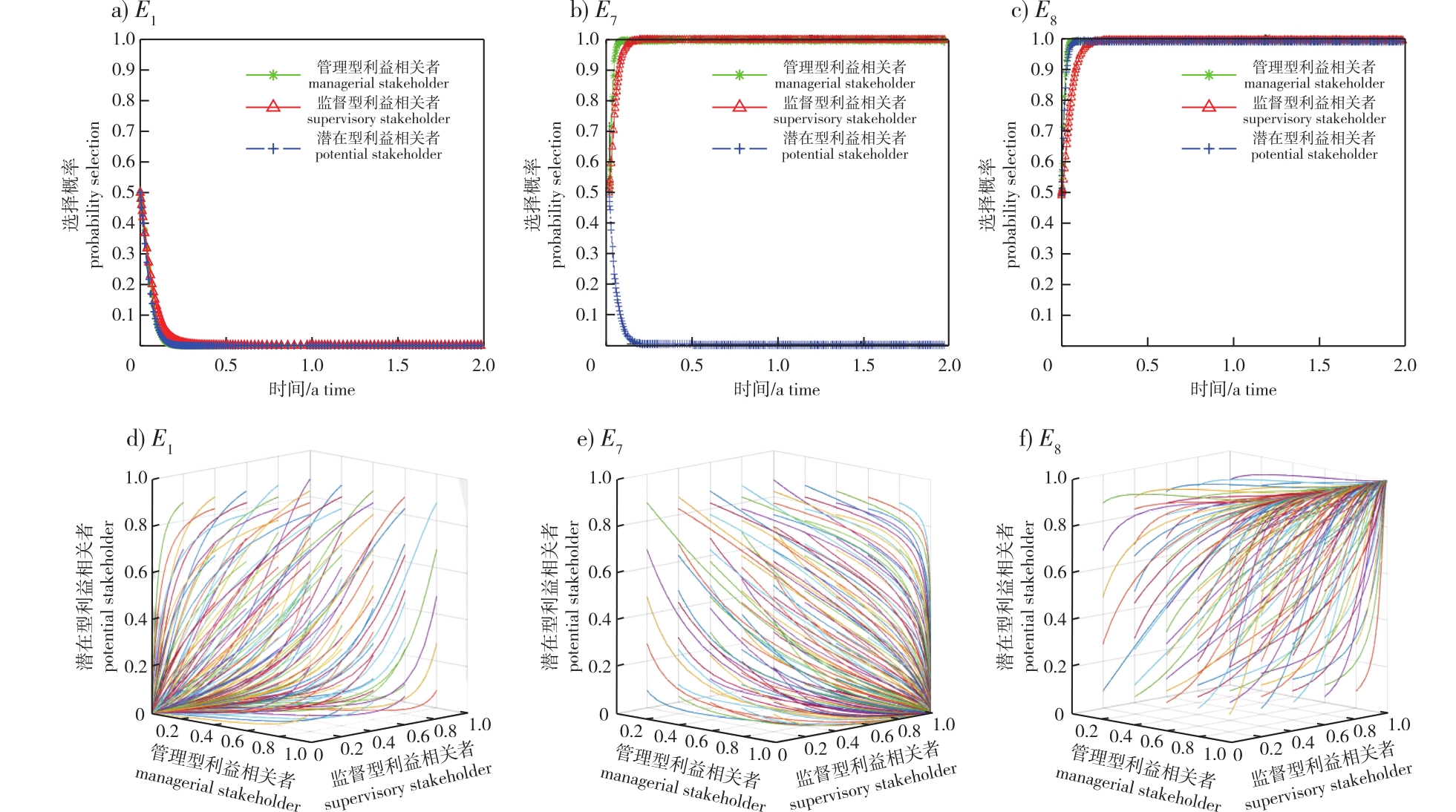 PDF(5669 KB)
PDF(5669 KB)


Research on the operation mechanism of forest chief system based on a tripartite evolutionary game
LI Yuan, WANG Chao, LIANG Yueying, XU Bin, NING Youliang
Journal of Nanjing Forestry University (Natural Sciences Edition) ›› 2025, Vol. 49 ›› Issue (4) : 253-262.
 PDF(5669 KB)
PDF(5669 KB)
 PDF(5669 KB)
PDF(5669 KB)
Research on the operation mechanism of forest chief system based on a tripartite evolutionary game
【Objective】The implementation of the forest chief system faces the dual challenges of vertical linkage and horizontal collaboration. Among them, horizontal collaboration is particularly difficult because it involves multiple interests and there is no strict hierarchical relationship between subjects, which has become a key bottleneck hindering the efficient operation of the forest chief system. Therefore, it is of great practical significance to clarify the interaction between the various horizontal stakeholders and promote the establishment of a horizontal cooperation mechanism.【Method】In this study, the horizontal stakeholders of the forest chief system were divided into management stakeholders, supervision stakeholders and passive stakeholders. Based on the stakeholder theory, a theoretical analysis framework was constructed, and a three-party asymmetric dynamic evolutionary game model was established. The evolutionary stability and evolutionary path of each party’s strategy selection were simulated and analyzed.【Results】(1)The importance of ecological location, the richness of forest resources, the development level of forestry industry, and the attention of superior departments and local governments were the external factors affecting the choice of horizontal cooperation behavior of the three parties, which affected the expected benefits and costs of the choice of horizontal cooperation behavior of the three parties. (2)The expected return and the cost were not only the internal factors that affect the choice of the three parties ‘horizontal cooperation behavior, but also the key variables that determine the choice of the three parties’ behavior. (3)It’s a difficult problem to mobilize their participation enthusiasm in the horizontal cooperation of the forest chief system, because some passive stakeholders were outside the forest chief system.【Conclusion】To strengthen the horizontal cooperation of the forest chief system, it’s key to accelerate the construction of a long-term mechanism which could follow the principles of restraint and incentive compatibility of all parties, and they form collective action through improving the assessment system and reward and punishment system. The purpose of the horizontal cooperation is to promote the transformation of the forest chief system from “nominal” to “real” as soon as possible, from comprehensive establishment to comprehensive effectiveness, and to achieve the unity of name and reality.

stakeholders / forest chief system / tripartite evolutionary game model / horizontal collaboration mechanism / collective action
| [1] |
林震, 孟芮萱. 以林长制促“林长治”林长制的制度逻辑与治理逻辑[J]. 福建师范大学学报(哲学社会科学版), 2021(16): 57-69.
|
| [2] |
林震, 孟芮萱. 以林长制统领新时代林业生态文明建设[J]. 国家林业和草原局管理干部学院学报, 2023, 22(2): 7-14.
|
| [3] |
刘广超. “林草兴”之于“生态兴”的基础性作用[J]. 福建师范大学学报(哲学社会科学版), 2023(1): 39-47.
|
| [4] |
侯方淼, 林煜国, 周珊, 等. 中国林长制改革的底层逻辑与发展历程及深化策略[J]. 世界林业研究, 2023, 36(4): 1-8.
|
| [5] |
朱凤琴. 安徽省林长制改革的制度创新与提升路径[J]. 林业资源管理, 2020(6): 6-12.
|
| [6] |
陈玉新, 高焕, 梁洪源, 等. 河北省全面推行林长制的做法、面临困难与对策探析[J]. 河北林业科技, 2023(1): 54-57.
|
| [7] |
胡亮. 趋同式环境治理:基于“林长制”实践的分析与反思[J]. 南京工业大学学报(社会科学版), 2021, 20(3): 65-77,110.
|
| [8] |
宁攸凉, 韩锋, 赵荣, 等. 整体性治理视角下林长制改革研究. 林业经济, 2019, 41(9): 93-98.
|
| [9] |
秦国伟, 董玮, 田明华. 林长制改革的内涵机制、逻辑意蕴与生态扶贫——以安徽省为例[J]. 生态经济, 2020, 36(12): 213-217.
|
| [10] |
秦柳, 姚文玲. 林长制的治理逻辑与优化路径[J]. 东岳论从, 43(9): 81-88.
|
| [11] |
|
| [12] |
郭阳, 范和生. 林长制改革: 历史脉络、现实困局与未来路向——基于安徽省政策文本与实践调查的双重分析[J]. 合肥工业大学学报(社会科学版), 2020, 34(4): 27-31.
|
| [13] |
|
| [14] |
陈宏辉, 贾生华. 利益相关者理论与企业伦理管理的新发展[J]. 社会科学, 2002(6): 53-57.
|
| [15] |
|
| [16] |
起晓星, 孙洁, 李建春. 演化博弈视角下生态农产品价值实现的政策机制[J]. 自然资源学报, 2023, 38(7): 1797-1814.
|
| [17] |
王越, 曾先, 刘钊宇, 等. 辽宁省耕地非粮化时空分异及其决定因素——多元利益主体决策的作用[J]. 资源科学, 2023, 45(5): 980-993.
|
| [18] |
何奇龙, 唐娟红, 罗兴, 等. 政企农协同治理农业面源污染的演化博弈分析[J]. 中国管理科学, 2023, 31(7): 202-213.
|
| [19] |
吕丹, 薛凯文. 农村集体经营性建设用地入市收益的分配演化博弈:地方政府角色与路径[J]. 农业技术经济, 2021(9): 115-128.
|
| [20] |
林煜国, 吴成亮, 侯方淼. 林长制改革的理论解释、历史回顾与制度效应[J]. 农业经济问题, 2023(8): 17-30.
|
| [21] |
|
| [22] |
|
/
| 〈 |
|
〉 |